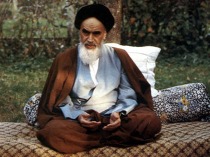This post is an installment in my quest to better understand the religious and ethnic drivers behind the loyalties of Iraqi Shiites and Iraqi Kurds during the Iran-Iraq war. This subject will be presented in the form of a research paper at the end of the semester.
A new symbol of Iranian influence has recently hit the streets of Iraq, billboards of Iran’s Grand Ayatollah Ali Khamenei. A recent article from the Associated Press states that the billboards, adorned with Khamenei “gently smiling” on the people below, appeared in Shiite neighborhoods in Baghdad and across Iraq’s Shiite dominated south. The article also cites other symbols of Iran’s growing influence in Iraq such as billion dollar trade deals and increased religious pilgrimage between the two nations. How should we interpret the growing role of Iran within Iraq? Are Iraq’s Shiites creating an Iranian ideological ‘province’? An answer of yes ignores the historical relationship between Iraq and Iran and overlooks the complexity of Shiite Islam in the region.
Iraq and Iran have a long history of shared trade and pilgrimage, long before nation-states or today’s borders existed. Many of Shiite Islam’s holiest sites are spread across the two countries: Basra, Najaf, and Karbala in Iraq and Mashhad and Qom in Iran. Long before border checkpoints and visas, religious pilgrims freely traveled between these sites. This movement of people eventually led to Arab Shiites settling in the western Iranian province of Khuzestan and Iranian
religious students populating the great Shiite schools of Najaf and Karbala. This migration across the border was heavily reduced throughout the reign of Saddam Hussein and the bloody eight year war between Iraq and Iran. The long and established history of religious migration between these nations shows that we should not be surprised as the number of pilgrims begins to climb in a post-Saddam Iraq.
Major differences exist between the political beliefs of Shiites in Iraq and Iran. A rift emerged between the religious leaders of each country over the appropriate role of religion in politics. The doctrine created by Ayatollah Ruhollah Khomeini, and still enacted in Iran, places religious scholars as guardians of the political system, with large amounts of power and the ability to guide elected leaders in the right, or Islamic, direction. The highest religious authorities in Iraq, Ayatollah Abu al-Qasim
al-Khoei and his successor Ayatollah Ali al-Sistani, believe that Iran’s approach gave religious scholars too much power over the Shiite community. Following Iran’s Islamic Revolution of 1979, Iraq’s Shiite community split between those who favored Khomeini’s doctrine, many of whom fled to Iran, and those who favored the teachings of al-Khoei and remained in Iraq. For those who remained in Iraq, two struggles emerged: one against a violent tyrant in Baghdad and one against an imposing religious force in Tehran.
Today, as the AP article correctly points out, this 40 year old theological and political argument is still strong. Iraq’s Grand Ayatollah Ali al-Sistani is 81 years old and many are beginning to look for his successor. Among those taking part in the search is Tehran, who is supporting its own candidate to lead Iraq’s Shiites. One who strongly believes in Iran’s guardianship form of government. Clearly, the relationship between Iraq and Iran is moving back toward its historical equilibrium but it is important not to view Iraqi and Iranian Shiites as one. A quote from the AP article sums it up best. “In the past, we used to encounter the pictures of the Arab dictator Saddam, but now pictures of the Persian dictator are taking over.”





